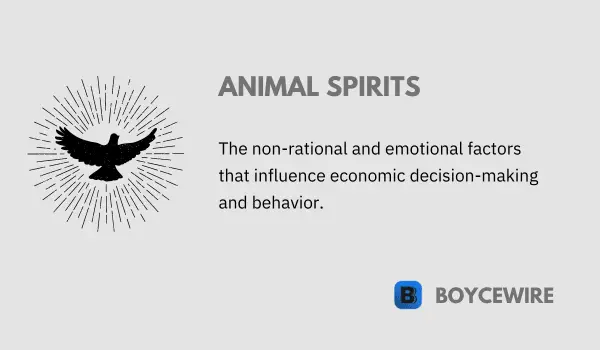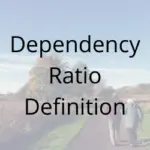Animal Spirits: Definition, Criticisms & Examples

What are Animal Spirits?
In the realm of economics, our actions are often considered rational, driven by data, and influenced by tangible factors like interest rates, income levels, or price changes. However, renowned economist John Maynard Keynes posited that our economic behaviors are also guided by more elusive forces—our “animal spirits.”
Animal spirits, a term Keynes coined in his 1936 book “The General Theory of Employment, Interest and Money,” refer to the human emotions and psychological factors that drive economic decisions. These encompass elements such as optimism, pessimism, confidence, fear, and other sentiments that cannot be mathematically modeled or easily predicted, yet have a significant impact on markets and economies.
Keynes argued that these animal spirits often lead individuals and businesses to make decisions that might not seem entirely rational from a purely economic perspective but make sense to the decision-makers given their emotional state or expectations about the future.
Key Points
- Animal spirits refer to the emotional and psychological factors that influence economic decision-making, such as consumer confidence, investor sentiment, and business optimism.
- They can have a significant impact on economic behavior, affecting spending, investment, and risk-taking decisions.
- Positive animal spirits can contribute to economic expansion, while negative ones can lead to a decline in economic activity.
The Role of Animal Spirits in Economics
Animal spirits play a pivotal role in economic dynamics, particularly within the framework of Keynesian economics.
Role in Keynesian Economics
John Maynard Keynes introduced the concept of animal spirits to help explain why decisions in the economy, particularly investment decisions, often diverge from what would be expected in a purely rational system. Keynes suggested that the volatile and unpredictable nature of animal spirits is what leads to economic cycles of booms and busts.
According to Keynes, during optimistic periods, or when investor confidence is high, individuals are more inclined to take risks, which stimulates economic growth. Conversely, during times of pessimism, or when investor confidence is low, individuals tend to be risk-averse, which can dampen economic activity.
How Animal Spirits Affect Market Movements
Perceptions of market sentiment play a significant role in influencing fluctuations within financial markets. Often, market trends align with the collective mood of investors rather than being solely driven by underlying economic fundamentals. For instance, during a bull market, the increasing prices can foster a sense of optimism that spurs further buying, thereby propelling prices even higher. This phenomenon exemplifies the impact of investor sentiment in action.
Similarly, in a bear market, falling prices can breed pessimism, leading to more selling and further price declines. These swings in market sentiment can create self-perpetuating cycles that drive prices away from what the fundamentals might suggest is their “true” or “intrinsic” value.
Elements of Animal Spirits
While “animal spirits” is a somewhat nebulous term, it generally encapsulates five key psychological factors that drive human behavior in economic contexts. These are confidence, fairness, money illusion, corruption and bad faith, and the power of stories.
1. Confidence
Confidence, arguably the most influential animal spirit, refers to the level of optimism or pessimism that consumers, investors, or businesses may have about the future of the economy. It is largely emotional and can be impacted by a variety of factors, from political stability to media coverage. High confidence often leads to increased spending and investment, fueling economic growth, whereas low confidence can result in reduced economic activity.
2. Fairness
The notion of fairness significantly influences economic behaviors. People tend to prefer transactions that they perceive as fair, even if this perception leads to economic decisions that might appear irrational in a strictly financial sense. For instance, a worker may refuse a higher-paying job if they perceive that the company exploits its employees.
3. Money Illusion
Money illusion refers to the tendency of people to think of currency in nominal terms, rather than in real terms. In other words, people often ignore the effects of inflation. For example, an individual might be happy with a 2% pay increase, even if inflation is 3%, effectively resulting in a decrease in purchasing power.
4. Corruption and Bad Faith
The presence of dishonesty, corruption, or bad faith in economic transactions can impact the overall level of trust and confidence in a market or economy. If corruption is widespread, it can discourage investment and hamper economic growth.
5. Stories
The power of stories refers to how narratives or popular ideas can shape our economic behavior. A compelling narrative—like a news story about a successful startup—can cause investors to act in ways that propel a stock’s price upwards, even if the company’s underlying financials don’t justify such a price.
Each of these elements plays a significant role in shaping our economic decisions, and together, they contribute to the ebb and flow of economic activity. As we’ll see in the next sections, these animal spirits can have substantial effects on key economic indicators and policies.
Influence of Animal Spirits on Economic Indicators
The elusive nature of animal spirits and their ability to sway individual and collective decisions means that they can significantly impact various economic indicators. Let’s explore some key influences:
- Impact on Consumer Confidence Consumer confidence is directly influenced by the animal spirit of confidence. When consumers are optimistic about the future, their confidence levels increase, leading to more spending. This, in turn, can stimulate economic growth as consumption is a major component of most economies. Conversely, when consumer confidence is low, spending may decrease, potentially leading to economic stagnation or recession.
- Effect on the Business Cycle The animal spirits can play a substantial role in shaping the business cycle — the natural rise and fall of economic growth that occurs over time. During periods of economic expansion, high levels of confidence can result in increased business investment, further driving economic growth. However, during periods of economic contraction, low confidence can cause businesses to cut back on investment, exacerbating the downturn.
- Influence on Stock Market Volatility Stock markets, being reflections of the collective mood of investors, are notably susceptible to the influences of animal spirits. When market participants exhibit a positive outlook, markets can witness periods of bullish activity, wherein prices tend to surpass fundamental justifications. Conversely, when pessimism prevails, markets can enter bearish phases, characterized by prices falling below intrinsic values. Such dynamics can contribute to increased market volatility.
These are just a few examples of how animal spirits can shape economic realities. In the next section, we will explore how policymakers factor in these psychological influences when shaping fiscal and monetary policy.
Animal Spirits and Economic Policy
Recognizing the influence of animal spirits is vital in crafting effective economic policy. Both fiscal and monetary policies can be used to manage these psychological factors and influence economic outcomes.
- How Policymakers Account for Animal Spirits Understanding the mood of consumers and investors allows policymakers to anticipate and respond to potential economic fluctuations. For instance, if consumer confidence is high and spending is robust, policymakers might take a more cautious approach, implementing policies to prevent the economy from overheating. Conversely, during periods of low confidence and reduced spending, they might enact stimulative policies to boost economic activity.
- Fiscal and Monetary Policy In fiscal policy, government spending and taxation decisions can be influenced by the state of animal spirits in the economy. For example, in times of economic downturn when consumer and business confidence is low, governments may opt to increase spending or cut taxes to stimulate the economy and boost confidence.
Monetary policy can also be tailored in response to animal spirits. Central banks, such as the Federal Reserve in the U.S., can adjust interest rates to influence the levels of spending and investment in the economy. Lowering interest rates can encourage borrowing and stimulate spending during times of low confidence, while raising interest rates can help cool down an overheating economy during periods of high confidence.
This strategic use of fiscal and monetary policy can help stabilize the economy, smoothing out the peaks and troughs of the business cycle that are often driven by the animal spirits.
Criticisms and Limitations of Animal Spirits
While the concept of animal spirits has been influential in economics, it is not without its critics and limitations. Here are some points of contention:
1. Empirical Evidence and Challenges
One of the main criticisms of the animal spirits concept is the difficulty in quantifying it. In contrast to conventional economic indicators such as interest rates or GDP, psychological aspects such as confidence and optimism are not readily measurable or predictable. This poses a challenge when it comes to empirically testing theories related to these psychological factors.
2. Criticisms from Different Economic Schools
Certain economists, particularly those belonging to the neoclassical and rational expectations schools of thought, criticize the concept in question for challenging the principle of rationality in economic decision-making. They posit that economic agents are inherently rational and proficiently utilize available information, rendering the concept of animal spirits redundant when it comes to explaining economic phenomena.
Although these critiques raise legitimate issues, numerous economists continue to find merit in the notion being discussed. They contend that it encapsulates crucial facets of human behavior that are frequently overlooked in conventional economic models. In the subsequent section, we will examine real-life instances that illustrate the impact of the factors under discussion.
Examples of Animal Spirits
Observing animal spirits in the real world underscores their influence on economic activities. Here are a few examples:
1. The Dot-Com Bubble
The dot-com bubble of the late 1990s provides a clear illustration of animal spirits at work. Enthusiasm and optimism about the potential of internet-based businesses led to a surge in investment, pushing stock prices to extremely high levels. Even though many of these companies were not profitable, investors continued to buy, driving up prices. When the bubble burst, many of these companies went out of business, leading to significant financial losses.
2. The 2008 Financial Crisis
The 2008 financial crisis also showcased the influence of animal spirits. Prior to the crisis, high levels of confidence led to increased borrowing and risk-taking in the housing market. When the bubble burst, confidence plummeted, leading to a severe contraction in economic activity.
3. COVID-19 Pandemic and Market Volatility
The COVID-19 pandemic offers a more recent example. The uncertainty and fear brought on by the pandemic led to massive sell-offs in global stock markets in early 2020, followed by a rapid recovery later in the year. This rollercoaster ride was heavily influenced by changing sentiments and expectations — the essence of animal spirits.
FAQs
Animal spirits refer to the emotional and psychological factors that influence economic decision-making, such as consumer confidence, investor sentiment, and business optimism.
Animal spirits can have a significant impact on economic behavior, as they influence spending, investment, and risk-taking decisions. Positive spirits can drive economic expansion, while negative spirits can lead to a decline in economic activity.
Factors such as economic conditions, political stability, consumer sentiment, business outlook, and market expectations can all influence animal spirits. Events such as financial crises, political uncertainty, or technological advancements can have a significant effect.
Animal spirits can contribute to market trends by influencing investor behavior and market sentiment. Positive spirits can lead to bullish market conditions, characterized by increased buying activity and rising prices. Conversely, negative spirits can contribute to bearish market conditions, characterized by selling pressure and falling prices.
About Paul
Paul Boyce is an economics editor with over 10 years experience in the industry. Currently working as a consultant within the financial services sector, Paul is the CEO and chief editor of BoyceWire. He has written publications for FEE, the Mises Institute, and many others.

Further Reading
 Third Degree Price Discrimination: Definition, Examples & Graph - When business charge customers different prices based on their demographic or other characteristic.
Third Degree Price Discrimination: Definition, Examples & Graph - When business charge customers different prices based on their demographic or other characteristic.  Dependency Ratio: Definition, Formula, Effects & Example - The dependency ratio is the percentage of children and those over 64 years old, compared to the people who are…
Dependency Ratio: Definition, Formula, Effects & Example - The dependency ratio is the percentage of children and those over 64 years old, compared to the people who are…  Rational Choice Theory: Definition, Pros, Cons & Examples - Rational choice theory is a concept that assumes people make rational choices which align to their own self-interest.
Rational Choice Theory: Definition, Pros, Cons & Examples - Rational choice theory is a concept that assumes people make rational choices which align to their own self-interest. 